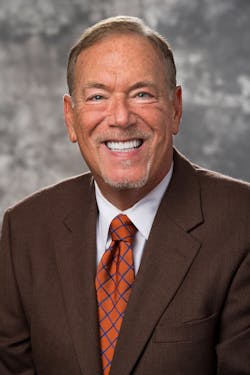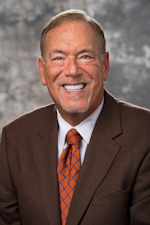‘Forward-Facing’: Could Facial Recognition Turn Back the Clock on the U.S. Airport Experience?
If you flew commercially prior to 9/11, you can recall how different the experience used to be. You could pull up to the airport 15 minutes before the flight, speed-walk to the gate, flash your boarding pass and take your seat on the plane. If your heart was racing, you saw it as a consequence of your own tardiness—not fear of terrorism or outrage over the sluggish pace of the security line. By contrast, the post-9/11 “new normal” is one in which travelers feel compelled to get to the airport two or three hours early. They expect major and minor stresses alike, everything from unruly passengers shouting at gate attendants, to the awkwardness of holding up your pants while your belt sits in a plastic box on a conveyer.
Fortunately for airport operators, some encouraging signs suggest that this state of affairs could change. An optimist might even wonder whether a trip to the airport in 2029 will feel a bit like a throwback to 1999. Chalk it up to rapid advances in biometric ID technologies as well as the evolution of highly efficient approaches to passenger pre-check. One technology in particular—facial-recognition scanning—could be a game-changer. But as our society adjusts to what can seem, at least to some, like an invasive change, the aviation industry will need to handle the onboarding of this technology with care and sensitivity.
Hints of a Brighter Future
Government officials and aviation professionals have been working for years to break up the logjams at airport security checkpoints. Launched a decade after 9/11, TSA PreCheck has spread to at least 200 airports and 67 airlines. The program allows low-risk domestic travelers to move through security with minimal disruption, reportedly with wait times of less than five minutes on average. In addition to forking over an $85 enrollment fee, TSA PreCheck travelers must undergo fingerprinting and submit to an in-person interview. Meanwhile, the newer, privately administered CLEAR program is now up and running at more than 45 airports. It marks a further advance in futuristic security screening. With its slogan “You’re the perfect person to verify your identity,” CLEAR relies on fingertip and retinal scans to rapidly ID travelers. They pay a $15 monthly fee to zip to the head of security lines.
Airports across the globe are also investing in facial-recognition systems that promise to, in essence, transform the entire terminal into an always-on security checkpoint. Encino, California-based startup FaceFirst (the author has no relationship to this company) bills its Guardian system as a way to “radically reduce friction, from curbside check-in to boarding the plane.” In promotional materials, FaceFirst contends that its AI-driven system, which works in tandem with surveillance cameras, is vastly superior to approaches that rely on humans to spot bad guys. “Guardian compares millions of images per second,” the company claims, “helping to identify travelers in checkpoints against a vast image database.” According to FaceFirst, at Panama’s Tocumen International Airport the Guardian system now regularly identifies fugitives wanted by INTERPOL. In addition to known terrorists, the company says the faces of luggage thieves, shoplifters, child-abductors and the like can be flagged in the system.
Meanwhile, more airports and airlines are sending digital images of passengers’ faces for crosschecking against biometric profiles in a database maintained by the Department of Homeland Security (DHS).
An Increasingly Vocal Opposition
The challenge here is that facial recognition clearly spooks some Americans. Over the past few months, vocal critics of these systems appear to have gained ground. At the time of this writing, San Francisco was poised to become the first major American city to ban government use of the technology. Meanwhile, the Bay Area cities Oakland and Berkeley, along with New York state lawmakers and officials in Somerville, Massachusetts, to name a few, were also taking aim at the technology, according to media reports.
Another headline-grabber was the $1 billion lawsuit, filed this past April, by a New York college student alleging that Apple had used facial recognition to falsely accuse him of shoplifting at several Apple stores around the Northeast. That same month, a JetBlue passenger’s outraged Twitter post went “viral” after she described being asked to peer into a camera prior to boarding a flight at JFK. (JetBlue has been running trials of the technology at different airports since 2017.) The passenger demanded to know how JetBlue knew her face and cried foul that she had never been asked to opt-in to this approach. “We should clarify, these photos aren’t provided to us, but are securely transmitted to the Customs and Border Protection database,” the airline responded online. “JetBlue does not have direct access to the photos and doesn’t store them.”
Such reassurances hardly mollify the likes of the Electronic Frontier Foundation or the ACLU. These and other privacy advocates have expressed alarm at U.S. government plans to roll out facial recognition for all international passengers at the top 20 American airports by 2021. They fret that airlines will get their hands on the data and use it in nefarious ways; that false positives will ruin lives; and that hackers will penetrate these systems, steal identities and otherwise invade travelers’ privacy. Alleged instances of racial bias by facial-recognition systems, and their alleged use to crack down on undocumented immigrants, have added fuel to the debate.
How Should Airports Respond?
For now at least, these systems clearly do stir fears of Big Brother in some quarters of our society. Should airport operators be concerned about being named in lawsuits over misidentifications, racial profiling and the like?
One key protection to keep in mind is the SAFETY Act of 2002. Passed in the aftermath of 9/11, it was designed to safeguard businesses offering products or services that stand to protect Americans from terrorism. Under the highest level of protection, registrants are exempt from certain punitive, exemplary and other damages. In addition, they cannot be forced to pay so-called non-economic damages unless the plaintiff suffers physical harm. That means that embarrassed or offended travelers—including, potentially, those misidentified as terrorists by facial-recognition technology—would be barred from capturing large sums in court for the likes of emotional pain and suffering, so long as the system had been successfully registered. The SAFETY Act also provides for a more limited qualification that can be used to insulate companies from liability as they field-test, validate and develop new products or systems.
For airport operators, the key here is that SAFETY Act protections flow from manufacturers to end-users. The CLEAR program, for example, is SAFETY Act-protected, which means stadiums and airports can join without fear of accruing liability exposure as a result. When it comes to facial recognition, then, airports and airlines should make sure that the creators of these products and services have secured SAFETY Act registration. This will allow them to buy, or agree to test, facial-recognition systems with a sense of self-protection.
In a recent search of approved technologies at safetyact.gov, keywords such as “facial” and “facial recognition” turned up just two companies—MorphoTrust USA and Cross Match Technologies—that had won SAFETY Act protection. A wide variety of screening-related vendors have successfully registered, to be sure, and companies that work directly with TSA enjoy an expedited approval process. However, airlines and airports would do well to double-check the SAFETY Act status of any and all security-related manufacturers, designers or service-providers with which they work or have buying relationships.
The PR DimensionUltimately, litigation may not be the greatest threat to facial recognition technology in aviation; rather, that could come in the form of growing public distrust spurred by outrage-laced social media storms, conspiracy theories and negative headlines. The JetBlue incident highlights how important it is for airlines and airports to be proactive about countering misinformation and making sure passengers understand how these systems work.
Through signage, social media messaging and other means, the industry needs to make abundantly clear when and how people can opt-out of the scans (and if they cannot, as with whole-terminal scanning, airports need to be upfront about it). Travelers also need to know that their biometric data will never be shopped around globally, Facebook style. Moreover, it is critically important to avoid the kind of disastrous security breaches that have affected the likes of Yahoo, Target and Equifax. Given that this technology is relatively young and is bound to have the expected bugs and errors, screeners also need to be trained to anticipate misidentifications. When they get a “hit,” they should respond professionally, take the passenger to the side and engage in a standard ID check. Aggressive “red alert” responses to misidentified passengers are a PR nightmare in the waiting. No doubt about it—they will be filmed and posted within seconds of occurring, if not in real time.
Facial recognition technology is here to stay. Millions of Americans already use it to unlock their Apple iPhones, and these systems will undoubtedly get faster and more accurate by the day. Could stakeholders in U.S. aviation leverage the technology to essentially roll back the clock on the airport experience? Given the effects of consolidation, extreme weather and other factors, that may be overly ambitious. On the other hand, FaceFirst cites the potential for a combination of facial-recognition technology, walk-through scanners (they can scan multiple travelers at once without any need to stop or even slow down) and 3D CT scans for carryon luggage to radically improve the speed and efficiency of the security-screening process. The upper limits of what is possible, in other words, may outpace our imaginations—so long as we handle these tools skillfully and build in the right safeguards.
Veteran aviation attorney Mark A. Dombroff is an Alexandria, Va.-based member of LeClairRyan and co-leader of the national law firm’s aviation industry practice; [email protected].






